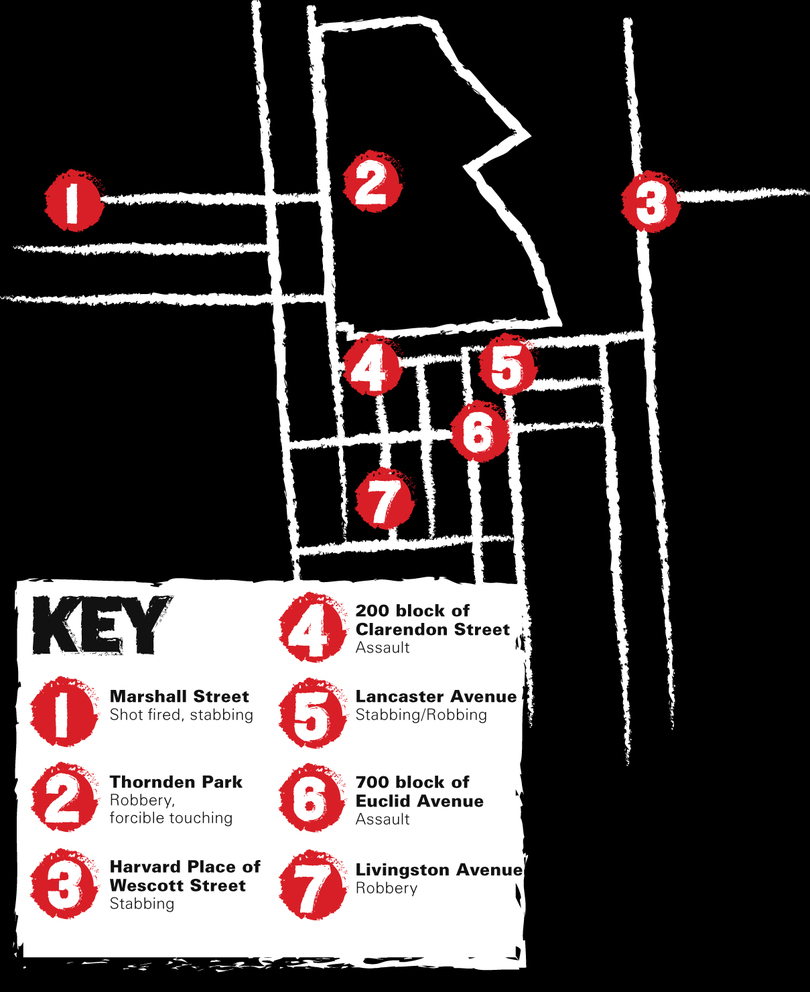Law enforcement responds to gang violence by breaking up off-campus parties

Ankur Patankar | Presentation Director
Police presence increased this past weekend due to more inner-city gang members, high school students and other Syracuse residents not affiliated with Syracuse University causing trouble in the area.
Law enforcement has tripled, and the Syracuse Police Department is working especially hard to crack down on East neighborhood parties. Reducing the number of parties reduces the opportunity for non-SU students to be near campus, said SPD Sgt. Tom Connellan.
“It’s the parties attracting the inner-city gang members,” Connellan said. “That’s what’s dragging them to the neighborhood.”
An incident involving non-SU students took place at a party on the 700 block of Euclid Avenue on Friday night, in which Syracuse residents were refused entrance into the party without paying. The Syracuse residents became violent and forced entry inside.
“They kicked the door open and then my friend got sucker-punched by one of them,” said Lee Meller, a junior education and history major. “They were townies, two boys and two girls.”
Meller said two of the residents hit him as well. He went to the hospital that night with his friend, who ended up getting stitches.
What’s attracted non-SU students and inner-city gang members to the SU area is the opportunity for them to steal from “rich kids,” said Common Councilor Bob Dougherty. Oftentimes, when a kid is seen riding around on a nice bike on the South or West sides of Syracuse, it is suspected they’ve stolen it from the campus area, or what Dougherty refers to as “brick city.”
“They’ll rationalize it as, ‘Oh, these kids are rich, it’s OK to steal from them,’” he said.
On Thursday, the city of Syracuse became one of nine cities to receive a $300,000 grant through the Bureau of Justice Assistance’s Violent Gang and Gun Crime Reduction Program for a program called “Syracuse Truce.” The program aims to bring positive change to neighborhoods that have been significantly affected by gun crime and gang violence, such as the West and South sides of the city.
There are about 25 different gangs in Syracuse, or a couple of gangs in every neighborhood of the city, Dougherty said. Each neighborhood has its own gang — the 110 gang is located around Bellevue Avenue, the 1500 gang organizes near the 1500 block of South Avenue and the Lex gang circulates on Lexington Avenue, he said.
“These gangs aren’t like the Crips or the Bloods; we don’t have any national gangs here,” Dougherty said.
The gangs, he said, usually form from young kids who begin to steal cars and break into houses out of boredom. Dougherty said he hears about a new street gang every week.
Several other incidents involving inner-city gang members and non-SU students have been reported in the past few weeks near campus. These incidents include an assault on Clarendon Street in which three “uninvited non-students” punched and kicked two SU students, and an incident in which a Syracuse teenager was accused of robbing and stabbing a Lancaster Avenue resident.
Two occurrences taking place on Marshall Street — a shot fired and a stabbing — have prompted much discussion among the SU community regarding the danger of gangs near campus.
“We have seen known gang members up in the area, but less often in the past few weeks,” said Connellan, the SPD sergeant. “It first began up around Marshall Street last year, and then moved into the East neighborhood this year with all the parties happening.”
Gang violence has been a consistent problem in the city of Syracuse for several years, he said. The trouble usually involves gang-on-gang violence, but in cases of shootings there is always a probability that an innocent person will be injured, Connellan said.
“So when a shot’s fired at 2 in the morning on Marshall Street, we’re concerned,” he said.
Recently, the gangs have become more aware of the cops and are more careful tagging with graffiti in certain areas. Though they want notoriety, they also want to avoid arrest, and so the younger members are the ones who will blatantly flash their colors, Dougherty said.
In regard to cracking down on inner-city gangs, Dougherty said past policies, such as the Racketeer Influenced and Corrupt Organizations Act indictment that holds gang members accountable for a 10-year period, have been effective in eliminating some of the worst offenders on the street. The indictment imprisoned murderous gang members, and in 2003 lead to the discovery of 26 members of Syracuse’s most violent gang at the time, the Boot Camp gang, according to the SPD Investigations Bureau website.
Since then, the anti-racketeering law resulted in the indictment of 16 violent Elk Block gang members in 2005, and the arrests of 14 Brighton Brigade gang members in 2006 and 11 gang members in 2007, according to the website.
The newly received grant aims to reduce gang violence even more by approaching the issue with different methods, such as enhanced enforcement, street outreach, community organizations and call-in meetings.
The goal, for now, is enriching the lives of kids who could become members of gangs — the fatalistic kids who see narrow futures that lack college or career options, Dougherty said.
“It’s offering them another way of life,” Dougherty said. “That’s what we’ll be doing.”




